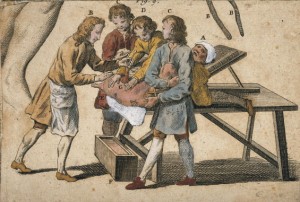Last weekend I got to take a fun trip to the hospital again and explore the world of kidney stones!!! At least I had a clean ER, and a nice morphine drip to get me through (and now that I’m home, lots of cranberry juice and a pile of Jane Austen DVDs to take my mind off it all!). I decided to take a look at what it was like to pass a kidney stone in the olden days. Much as I suspected, it was not much fun, but I have a lot of company, going back to ancient Egyptian mummies….
 Sir Arthur Sullivan of Gilbert-and-Sullivan fame suffered from stones for years, which I am sure explains the scene in one of my favorite movies Topsy Turvy where he is screaming, falling down, injecting himself with morphine, and still insisting on climbing up on the podium to conduct. Michelangelo suffered from stones, and may have died from the obstruction. Composer Giovanni Gabrieli also died from the ailment in 1612. Napoleon III of France was distracted from the Franco-Prussian War by stones, and Napoleon I was at the Battle of Borodino in September of 1812 (one source says “This condition may help explain his unoriginal tactics during this battle”).
Sir Arthur Sullivan of Gilbert-and-Sullivan fame suffered from stones for years, which I am sure explains the scene in one of my favorite movies Topsy Turvy where he is screaming, falling down, injecting himself with morphine, and still insisting on climbing up on the podium to conduct. Michelangelo suffered from stones, and may have died from the obstruction. Composer Giovanni Gabrieli also died from the ailment in 1612. Napoleon III of France was distracted from the Franco-Prussian War by stones, and Napoleon I was at the Battle of Borodino in September of 1812 (one source says “This condition may help explain his unoriginal tactics during this battle”).
Michel de Montaigne wrote “I am at grips with the worst of all maladies, the most sudden, the most painful, the most mortal, and the most irremidiable.” James I was found to have stones in his bladder and kidneys after death, as did Samuel Pepys, who famously underwent pre-anaesthesia surgery and then carried around the stone with him to show anyone who would look (his post-mortem found “a nest of no less than seven stones” in one kidney). Peter the Great suffered from them in 1725, and Empress Anna of Russia in 1740. George IV had them (which is no surprise–what illness did the guy not have??), and probably Henry VIII. So did George Eliot.
Oliver Cromwell, his doctor wrote, “being much troubled with the stone, he used sometimes to swill down several sorts of liquor, and then stir his body by some violent motion…that by such agitation he might disburden his bladder.” (Drinking copious amounts of alcohol seems to have been the number one treatment, along with “blistering with cantharides”. I was tempted to down some vodka to make it feel better, but blasting the stones into sand-like bits then washing them out with a saline drip seemed to work better…)
 Erasmus, Caesar, and Pilgrim Myles Standish (who died “in dolorous pain”) also had stones. And, famously, there was a Dutch blacksmith named Jan de Doot who had his portrait painted in 1651 with a stone he removed from his own perineum with a kitchen knife. Ugh.
Erasmus, Caesar, and Pilgrim Myles Standish (who died “in dolorous pain”) also had stones. And, famously, there was a Dutch blacksmith named Jan de Doot who had his portrait painted in 1651 with a stone he removed from his own perineum with a kitchen knife. Ugh.
Now that I have made myself feel so much better with this research (not!) I am going to watch some more Pride and Prejudice and drink my lemon water. RWA is coming up in just a couple of weeks, after all, and I need to feel 100%! What is your favorite historical surgery story? Any kidney stone prevention tips I can use in the future?

I really like it when folks come together and share ideas.
Great website, keep it up!